Scott Phillips, director of research at Motley Fool, has penned an article in Domainfax today arguing that Australian housing is “not as expensive as we think”:
What if housing really isn’t as expensive as it seems?…
Here’s the idea. As homeowners, and potential buyers, we’re trained to look at the price of the house. We treat it as an absolute number. Higher is bad, lower is good, if you’re a buyer (and the reverse if you’re selling). Which makes logical sense.
…but there’s a greater influence on our wealth when we borrow: interest rates. You don’t have to go far to find a Boomer who has a story of 17 per cent interest rates back in the 1990s. But even at today’s rates, over the life of a 30-year mortgage, you’ll pay more in interest than the cost of the house itself. So interest rates matter. A lot.
This is where it gets interesting. While the price of housing has skyrocketed over the last couple of decades (and nowhere more than Sydney and Melbourne), interest rates have fallen. Yet most of the ‘housing affordability’ discussion centres on prices compared to incomes. Can you see what’s missing from that picture? Yep, interest rates…
In fact, a 2016 report from CoreLogic and the Australian National University showed that while the average house price had risen meaningfully as a multiple of income, the actual affordability of that house — the monthly repayment required to pay the mortgage — was better than 2010 and much better than 2008.
Because? Interest rates…
I don’t blame would-be buyers for being spooked by seven-figure house prices. It feels crazy. And I don’t know that I’d be rushing out to buy right now, either. But if interest rates stay low for an extended period, all that worry might be for nought.
This is the same old argument that has been put forward time and time again by defenders of the bubble.
Sure, mortgage rates today are far lower than they were in the late-1980s and early-1990s:
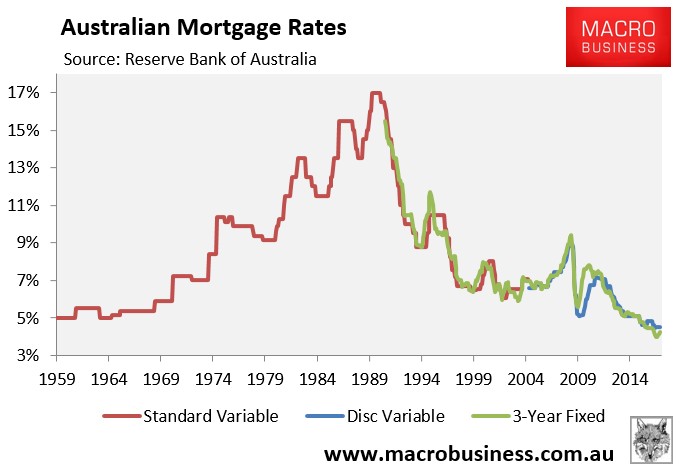
But mortgage rates back in those days did not stay sky-high for long and a home buyer back then got to enjoy the benefit of a massive drop in mortgage rates over subsequent years and a corresponding massive rise in home values. There’s no way today’s first home buyer will experience similar conditions in the years ahead, whereby mortgage rates fall by two-thirds and values grow almost exponentially.
Phillips, also failed to mention that average earnings growth is hovering around its lowest level in recorded history:
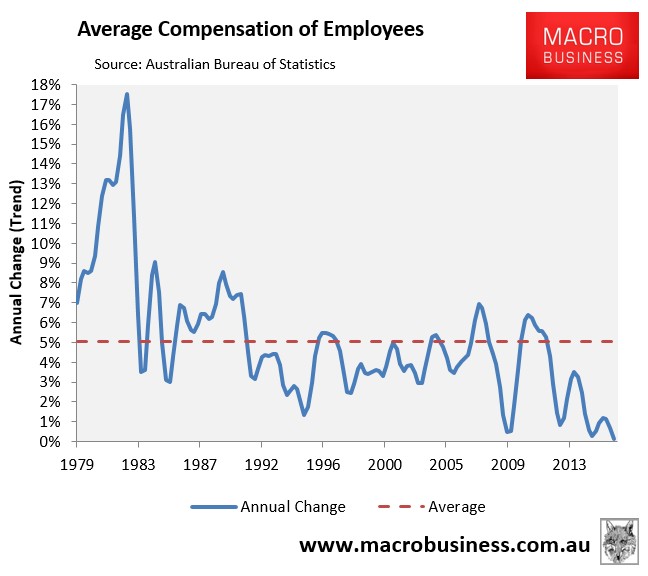
This means that it is going to be far more difficult for today’s mega-mortgage slaves to pay off their loans. A huge mortgage today will remain a very big mortgage in a decade’s time – a completely different scenario to the experience of prior generations of home buyers, whose debts were effectively ‘inflated away’ by higher inflation and wages growth.
Indeed, the key problem with Phillips’ housing affordability argument is that he only takes into consideration initial repayments on new mortgages, not repayments over the full 25 or 30 year loan term.
To illustrate why this is nonsensical, consider the below extreme stylised example, which comes from last year’s special report: Why common housing affordability measures are wrong.
Scenario A (very low price, very high inflation, extreme mortgage rate):
- Buyer has an annual income of $100,000.
- They buy a house valued at $300,000, (assume no deposit).
- The mortgage rate is 17%, which remains the same throughout the 25 year loan-term.
- Inflation is very high and wages grow at 7% annually (i.e. 10% real mortgage rate).
Scenario B (high price, very low inflation, very low mortgage rate):
- Has an annual income of $100,000.
- They buy a house valued at $700,000 (assume no deposit).
- The mortgage rate is 3.5%, which remains the same throughout the 25 year loan-term.
- Inflation is low and wages grow at 2% annually (i.e. 1.5% real mortgage rate).
In case you haven’t noticed, Scenario A is an extreme proxy for the late-1980s home buyer, whereas Scenario B is an extreme proxy for today’s home buyer.
It should be noted at the outset that while mortgage rates briefly hit 17% in 1989-90, they did not stay there for long. They have also never been as low as the 3.5% assumed above (4.5% is the lowest they have reached):
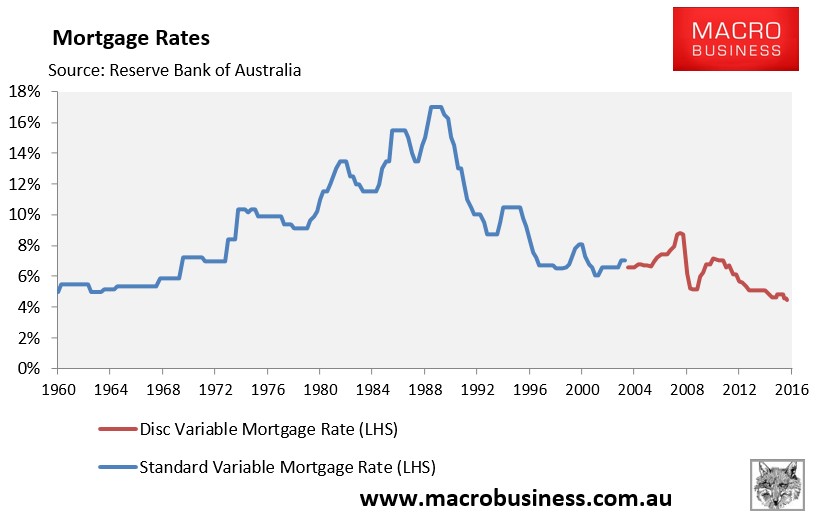
Similarly, real mortgage rates were only 10% briefly throughout the late-1980s and early 1990s (see next chart).
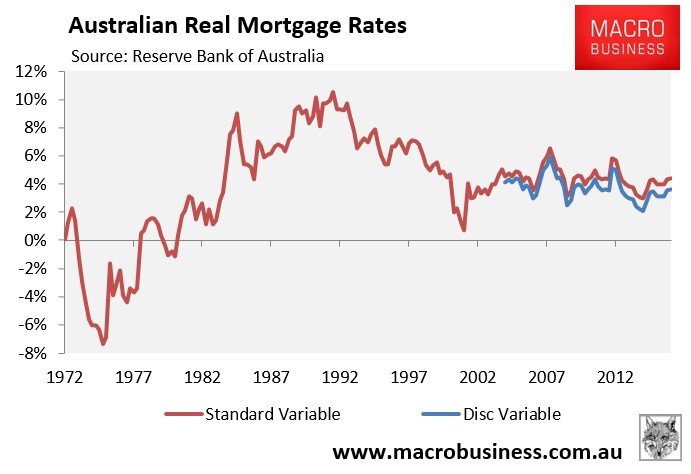
Nevertheless, even in the extreme stylised example above, the buyer in Scenario A only pays more in mortgage repayments for the first six years (see next chart).
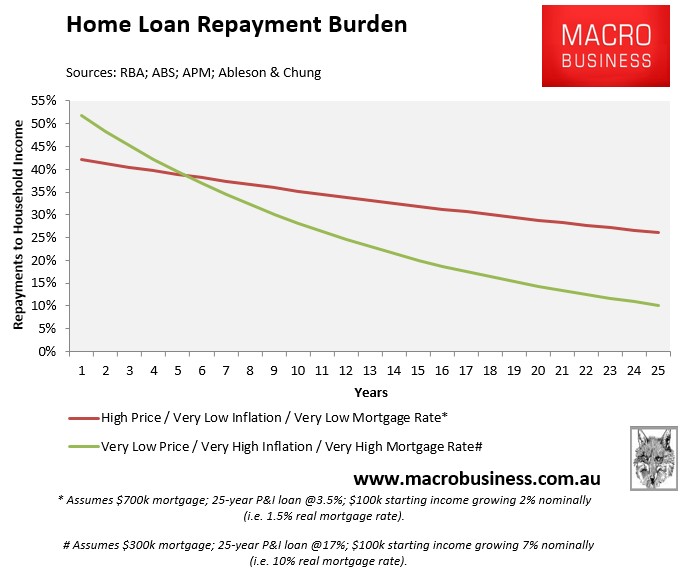
Thanks to the wonders of high nominal inflation and wages growth (and even in the face of a 10% real mortgage rate), Buyer A’s mortgage debt is inflated away quickly such that their mortgage repayments are:
- 28% of income after 10 years;
- 20% of income after 15 years;
- 14% of income after 20 years; and
- 10% of income in the final year.
Buyer B is not nearly as lucky, since their repayment burden remains high in the face of low inflation and low wages growth, even though they face a ridiculously low real mortgage rate of just 1.5%. Buyer B’s mortgage repayments are:
- 35% of income after 10 years;
- 32% of income after 15 years;
- 29% of income after 20 years; and
- 26% of income in the final year.
Therefore, low inflation and low nominal wages growth – as exists currently – means that a huge mortgage taken-out today will remain a very big mortgage for decades to come.
Coincidentally, today’s home buyer also faces the worst mortgage repayment burden in recorded history (again, see October’s special report for specifics):
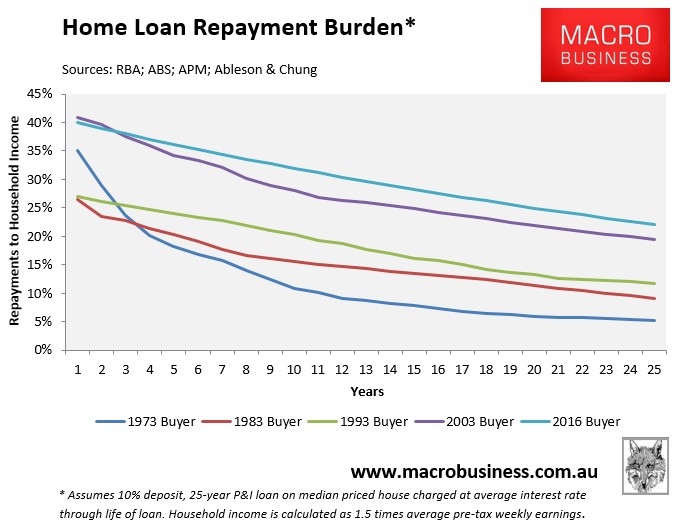
When talking about housing affordability, analysts must consider the mortgage repayment burden over the life of the loan rather than only at the very beginning. Phillips has failed in this regard.
Rather than low inflation/interest rates being a benefit to today’s home buyer, it will instead act as a millstone around their mortgaged necks for decades to come.

